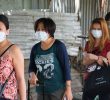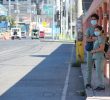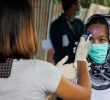DAVAO CITY – Health officials here worry over COVID-19 hitting households, infecting most of their members, citing it as the reason for recording the highest active cases at 7,931 with 700 new cases on September 9.
Davao City COVID-19 Task Force focal person Dr. Michelle Schlosser explained over Davao City Disaster Radio that household transmission is getting worse and could be seen as the cause of this sudden surge.
“Before there were only 1 or 2 members of the family who tested positive but now it’s the entire family,” Schlosser said.
The health official said family gatherings and events may have contributed to the high transmission of COVID-19, especially with the highly transmissible Delta variant.
“We cannot blame the people because it’s been almost two years already since we’ve started battling the COVID-19. But this is not the right time for reunions or gatherings. If you truly love your families and friends… If you miss them, you can reach out to them through social media,” Schlosser said.
The continuing rise of cases could overwhelm the healthcare system, she said, as Davao’s COVID-19 referral hospital, Southern Philippine Medical Center (SPMC), is now in full capacity with 492 COVID-19 beds occupied.
To ease the situation at SPMC, Mayor Sara Duterte-Carpio approved the Home Care Program of Davao Doctors Hospital (DDH) to provide alternative medical care for cases that could be treated at home.
Apart from the said strategy, the city government provides training to private establishments to augment contact tracing of F1 or first generation contact of a confirmed positive case, F2 or second generation contact and F3 or third generation contact.
Mobile vaccination in far-flung areas and series of inoculation drives in the city have been intensified to increase the number of people getting the shot.
As of September 7, first dose inoculation were administered to 606,865 residents in the city while 350,629 got their full-dose.
Davao City has logged 41,833 cases with 7,931 active, 32,625 recoveries and 1,277 deaths since the start of the pandemic in March 2020.










